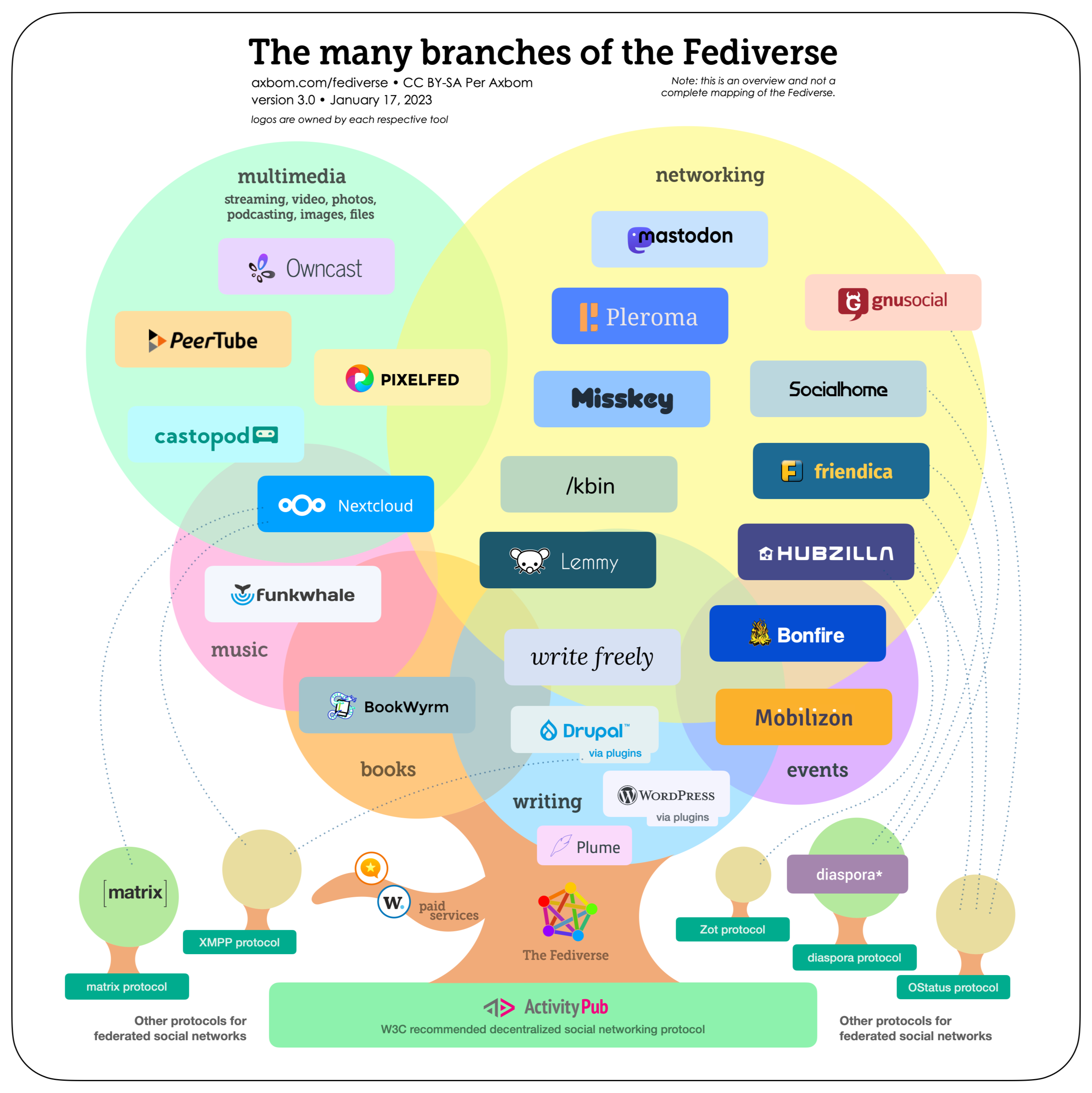Welcome to the Fediverse
Mastodon is a decentralised micro-blogging service which has gained lots of traction lately. Last week, I saw on Tidbits a couple of articles by Glenn Fleishman about Mastodon :
The first article is quite a good introduction for people who know centralized social networks (like Twitter or Facebook) and are savvy email users (as the analogy between Mastodon and email providers is very apt).
Tip: I think it's customary to write an introductory (pinned) post on Mastodon after having properly settled on a newly chosen instance (first time arrival or moved between instance), tagged with hashtag #introduction. I have yet to do mine, but it's on my TODO list...I reckon, for newcomers, the two pain points in getting into Mastodon are :
- How to choose a Mastodon instance to join in the first place
- How to follow someone by handle when they are on a different instance than yours which require some copy/paste as described in the article
For the first point, it might cause mental blocks, but knowing the following may alleviate that:
- You are not stuck forever with the instance you have chosen, you can migrate to another instance anytime and pretty seamlessly, and when you do so, you can take your followers list (and block list) with you
- There exists for newcomers easy-on-the-eye and nicely signposted curated and vetted lists of instances with details about the specifics of each that guide you in picking the instance that suit you the most (criteria being geography, interests, rules/codes of conduct). The official list from Mastodon is joinmastodon.org's server list, but there is another unofficial list at Fedi.garden that's popular too and seemingly equally curated. Picking an instance can thus become a deliberate, empowered activity rather than a chore.
Additionally, there is website called Fedi.tips, with extensive explanations, guidance and FAQ on Mastodon, it's a bit like the Hitchiker Guide to Mastodon.
Tip: Take the habits of boosting (Fediverse equivalent of retweeting) the posts you think are worth being in front of as many eyeballs as possible, because the federated nature of instances make it so that natural reach seems not optimal, and somehow boosting can get posts across more federated instances.
Regarding the second pain point, you could get used to it (I did), or use a browser extension for Firefox. I believe that extension exists for Chrome-based browsers as well. For mac users, there is also a Shortcuts-based method.
In any case, for me it's just a mild irritant rather than a real pain point. Adding followers is not what I do most on there, and also it's not systematic. I haven't quite pinpointed what magic rule make it so that sometimes I can see the profile of someone from another instance on a pane on my instance, and sometimes I'm taken to their instance when I click their avatar. It might be related to how well the other instance is federated with mine, but I'm not sure.
That said, those two points are some of the a-bit-too-salient features of the federated nature of Mastodon.
I guess another idiosyncrasy of Mastodon is its search functionality, which is a can of worm, I don't want to talk too much about this, especially as Tim Bray wrote enough on the topic.
Tip: If you are looking for a job or want to advertise a job, you can leverage the pervasive usage of hashtags on Mastodon, by tagging that type of post with the #GetFediHired tag.What about the Fediverse?
Wikipedia says:
The fediverse (a portmanteau of "federation" and "universe") is an ensemble of federated (i.e. interconnected) servers that are used for web publishing (i.e. social networking, microblogging, blogging, or websites) and file hosting, but which, while independently hosted, can communicate with each other. On different servers (technically instances), users can create so-called identities. These identities are able to communicate over the boundaries of the instances because the software running on the servers supports one or more communication protocols that follow an open standard.
I think this is where the analogy with how emails works starts to break down a bit, and that's what the second article from Tidbits is exploring and explaining.
The infographic included in the second Tidbits article is such a good overview of that network of services to the public, that I'll reproduce it here (I like my blog posts to be text only these days):

In practice, it means that not only you can interact with people on other Mastodon instances, but you can do the same with users of different services altogether.
For example, Pixelfed is a photo-sharing website, and from your instance of Mastodon you can follow someone's feed on Pixelfed without having to create an account there. It's like if you could follow someone's Instagram feed from your twitter feed! that's the power of a decentralised world. Instagram, Twitter and al, the are walled silos, feudal domains whose tech billionaire owner hoard and abuse your personal data like the yesteryear lords tax you to death.
Tip: Most admin of Mastodon instance are volunteer, they are doing hard work of moderating and face increasing cost of tech infrastructure. Some of them have setup fundraising and tip jar on Open collective, Patreon, ... Don't hesitate to contribute if you like the instance you've settled in.
Size-wise, the Fediverse is tiny compared to big social-media (there is this website trying to track the size of the Fediverse), but personally I like it that way. The fediverse feel more humane and approachable that way. There's no celebrities to stan, but I'm not that kind of person, and thankfully the Fediverse is not about that kind of usage for now.
I really like that the article spends some time talking about moderation in a decentralised ecosystem, and highlighting that the federated nature is both the strength and the weakness of those decentralized services. I watched an interesting video essay by Derek Caelin that dwell deeper on that topic, worth watching for its insights.
How do I relate to this all?
As for me, I am quite late to the game as I discovered Mastodon at the end of last year (Mastodon exists since 2016), like many people it seems, but unlike most, I'm not really a refugee: I have a Twitter account which I almost never use, so it is the buzz created by the change of ownership at Twitter and the subsequent migration of many people to Fediverse in general, and Mastodon in particular, that got me curious. I have vaguely heard of that thing, but from a distance and as some TODO item quite down in the list of things to explore. So I had a peek, I liked the village-y feel of it and some Mastodon functionalities (e.g: having both favourites and bookmarks) and community protocols (e.g: content warnings) are really neat and help improve the experience, so for that and other reasons, I'm now using it in earnest . Interestingly, it got me to blog more often too.
Regarding my Mastodon client of choice, I think I have quite an unpopular opinion. I have tried many apps on iPad and some on mac, and I disliked them all (including the official ones). I don't use Mastodon on my phone, because I don't do social media or gaming on the device I have most with me, because my time is way too precious...
So even good quality clients like Ivory are not for me. (there is even a debate about quality difference between Apple platforms and Android for Mastodon clients)
That said, I do like the website version of Mastodon very much (not sure it's full PWA, but I can still save it on my iPad's home screen): I like compartmentalising the view by setting up a column for each hashtag I like to follow, that's what works for me, and on the iPad (which is the device I use Mastodon the most with), it's a delight to use. I guess had the TweetDeck app had a Mastodon counterpart, that would have been the app closest to my way of functioning.
Tip: You can upload images to Mastodon, when doing so, the media editor will offer you the opportunity to add a caption (the field says Describe for the visually impaired. If doing so, you will make a lot of people who cannot see the media, very very happy, especially if you are going the extra mile of: not just plain description, but also add the feeling and/or the context . I have come across a few posts of visually impaired users who voiced their appreciation of the extra effort or got the post to trigger more conversations because of that.What's the next stop for me in my Fediverse exploration?
I was a heavy user of Meetup.com (both as organiser and participant) back in the days (before the last two years...), so I'm curious about their Fediverse alternative: Mobilizon and Bonfire.
Tip: I kept usingpostsin this blog. Actuallyposts(which aretweetsin Twitter) are calledtoots(orpouetsin French) in Mastodon. I'll get used to it...
Furthermore, it should be said that the infographic is not exhaustive, and the Fediverse is a very dynamic ecosystem with tons of projects happening. Lots of things to explore there. A couple of projects in there caught my attention not just because they exist, but because they are reminder of a situation that I feel impacted by as a developer: I'm talking about git forges, and how federation could break the monopolistic situation we are in, but that's another story for another day...
Finally, I must say I am pretty frustrated with the state of group chats these days, so slowly, but surely, the [matrix] is calling at me...
Wake up, Neo.
